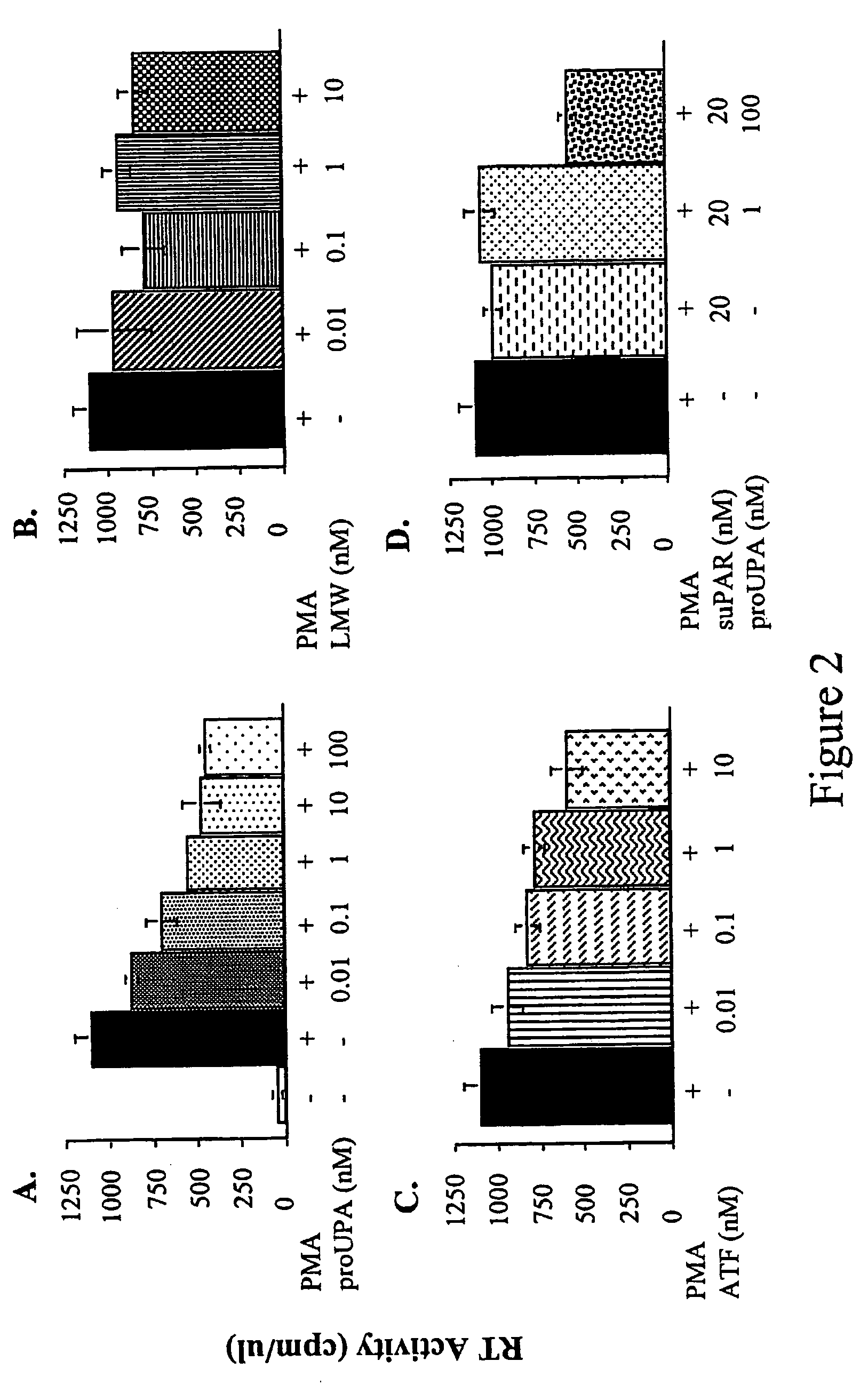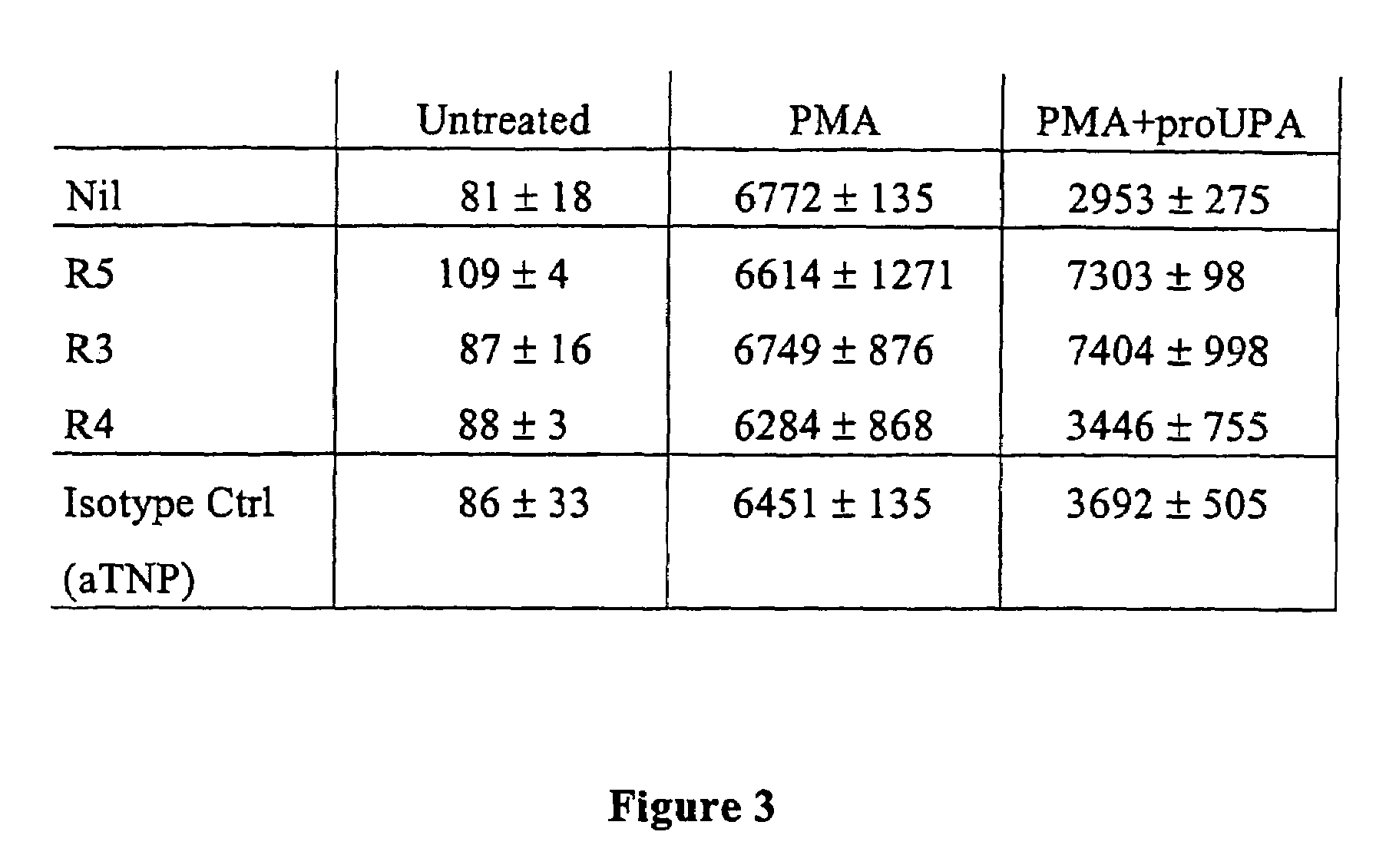Antibody against uPA/uPAR
an antibody and upa technology, applied in the field of upa/upar antibodies, can solve the problems of destructive and invasive phenotype, high levels of released su-par, and poor prognosis
- Summary
- Abstract
- Description
- Claims
- Application Information
AI Technical Summary
Benefits of technology
Problems solved by technology
Method used
Image
Examples
example 1
Pro-urokinase (pro-uPA) and its derivatives uPA and ATF, inhibit the replication of HIV-1 in latently infected monocytoid cell lines and in freshly infected human blood cells.
[0053]Latent HIV infected cells provide a cellular population resistant to anti-retroviral therapy and represent the mechanism for lifelong persistence of HIV (Finzi et al., 1999). The promonocytic U937 cell line is one of the most utilized models for studies on in vitro HIV infection. It displays both CD4 and CXCR4 and, therefore, can be infected by X4 viruses. From this cell line has been derived the chronically infected cell line named “U1”, containing two copies of integrated proviruses, and broadly used as a model of viral latency and reactivation (Folks et al., 1988). The U1 promonocytic cell line is one of the most thoroughly characterized models of post-integration latency. It was obtained from a population of U937 cells surviving the cytopathic effect of acute infection by HIV-1LAI / IIIB (X4), and conta...
example 2
Chemotaxis induced by uPA and “activated” uPAR fragments is mediated by the chemokine receptor FPRL1 / LXA4R.
[0078]UPA and uPAR induce and are required for the chemotaxis of monocytes, THP-1 leukemic cells and several other cells. The derivative of uPA, ATF (amino terminal fragment), or the pro-enzyme pro-uPA have the same effect. In addition, the activated forms of uPAR (cleaved after residue 84) also activate chemotaxis. For all these stimulants, and in all cells tested, the mechanism remains the same (Degryse, 1999; Degryse, 2001; Fazioli, 1994; Resnati, 1996). In particular, these agents eventually rely on the activation of a trans-membrane mediator. After binding to uPAR, uPA cleaves uPAR or modifies its conformation (“activation”) to make it cleaved by between domain D1 and D2. The data show that the so-“activated” uPAR must interact with trans-membrane mediator that in turn transduces the migratory signals of pro-uPA / uPAR (Fazioli, 1994) (Blasi, 1997). This is due to the fact t...
example 3
Inhibition of uPA / ATF / uPAR chemotaxis by anti-FPLR1 / LXA4R reagents.
[0103]The specific response of FPRL1 / LXA4R containing cells to D2D384-278 (FIG. 10) strongly suggests that the G-protein-coupled FPRL1 / LXA4R receptor is the mediator of uPA and “activated” uPAR-induced chemotaxis. To substantiate this hypothesis, we have used cells that contain several chemokine receptors, including FPRL1 / LXA4R, and have tested whether specific antibodies to FPRL1 / LXA4R inhibit ATF or D2D384-278 induced chemotaxis.
Materials and Methods
[0104]Materials
[0105]The anti-LXA4R / FPRL1 antibodies (Fiore, 1995) were a generous gift of Dr. Mario Romano (Chieti, Italy) and Clarles Serhan (Boston, Mass., USA).
[0106]Cells
[0107]THP-1 cells have been described before (Resnati, 1996). Monocytes were obtained by two rounds of centrifugation over Ficoll (1.077 g / l) and Percoll (Pharmacia Biotech.) gradients from peripheral blood of healthy volunteers. Briefly, heparinized blood was diluted 1:1 with PBS and 3 ml of Ficol...
PUM
| Property | Measurement | Unit |
|---|---|---|
| concentrations | aaaaa | aaaaa |
| concentrations | aaaaa | aaaaa |
| concentrations | aaaaa | aaaaa |
Abstract
Description
Claims
Application Information
 Login to View More
Login to View More - R&D
- Intellectual Property
- Life Sciences
- Materials
- Tech Scout
- Unparalleled Data Quality
- Higher Quality Content
- 60% Fewer Hallucinations
Browse by: Latest US Patents, China's latest patents, Technical Efficacy Thesaurus, Application Domain, Technology Topic, Popular Technical Reports.
© 2025 PatSnap. All rights reserved.Legal|Privacy policy|Modern Slavery Act Transparency Statement|Sitemap|About US| Contact US: help@patsnap.com



